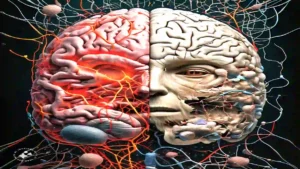Have you ever pondered the depths of the human mind, its capacity for both extraordinary resilience and unimaginable pain? Multiple personality disorder, now termed Dissociative Identity Disorder (DID), offers a haunting glimpse into the psyche’s complex defense mechanisms. It is a condition where the mind fractures, creating separate identities to cope with overwhelming trauma.
This exploration delves into the scientific underpinnings of DID, examining how the brain adapts to adversity. We will unravel the intricacies of this disorder, from its origins to its manifestations, and explore the journeys of those affected. Join us as we navigate the complex world of DID, seeking to understand, empathize, and illuminate a path towards healing.
Understanding Dissociative Identity Disorder or Multiple Personality Disorder:
Dissociative Identity Disorder (DID) is a complex mental health condition characterized by the presence of two or more distinct identities or personality states within one individual. These identities may have their own unique mannerisms, memories, and behaviors, often presenting challenges in daily life. Signs of DID can vary widely, including memory gaps, identity confusion, and experiencing these different personalities emerging at different times.
The causes of DID are rooted in severe trauma experienced during childhood, such as physical or emotional abuse. Diagnosing DID involves thorough psychological evaluations and assessments to differentiate it from other disorders with similar symptoms. Treatment typically involves psychotherapy to integrate the multiple identities into one cohesive sense of self.
Living with DID requires significant support from mental health professionals and loved ones to navigate the complexities that arise from managing various identities coexisting within one person.
What is Multiple Personality Disorder/Dissociative Identity Disorder (DID)?
Dissociative Identity Disorder (DID), previously known as multiple personality disorder, is a complex psychological condition where an individual’s identity is fragmented into two or more distinct personalities. Each personality may have its own mannerisms, memories, and behaviors that are unique from the others.
This fragmentation often occurs as a coping mechanism in response to severe trauma experienced during childhood, such as abuse or neglect. Individuals with DID may switch between these different identities involuntarily, leading to gaps in memory and a sense of detachment from their thoughts and emotions.
Also Read: Understanding Main Character Syndrome Fully
Living with DID can be challenging as individuals navigate their various identities and cope with the impact of past traumas. Therapy and support play crucial roles in helping individuals manage their symptoms and work towards integration and healing. It’s important for society to understand the complexities of DID and offer compassion rather than judgment towards those affected by this disorder.
Signs and Symptoms of Multiple Personality Disorder or Dissociative Identity Disorder (DID)
Living with Dissociative Identity Disorder (DID) can manifest in various signs and symptoms that may be confusing and distressing. Individuals with DID may experience gaps in memory, finding items they don’t remember buying, or waking up in different clothes without knowing how they got there. They might hear voices inside their head, each with distinct personalities and characteristics.
Feelings of detachment from oneself or surroundings are common among those with DID. It’s like watching your life as an outsider, feeling disconnected from emotions or actions happening to the body you inhabit. Some individuals might struggle with identity confusion, not recognizing themselves in the mirror or having a blurred sense of who they truly are.
These symptoms can impact daily functioning and relationships, leading to challenges at work or school due to memory lapses or sudden shifts in personality traits. Seeking professional help is crucial for accurate diagnosis and effective management strategies tailored to each individual’s unique experiences with DID.
Causes of Multiple Personality Disorder or Dissociative Identity Disorder (DID)
The causes of Dissociative Identity Disorder (DID) are complex and multifaceted. Trauma, particularly during childhood, is often a key factor in the development of DID. Severe emotional, physical, or sexual abuse can overwhelm a person’s ability to cope, leading to the fragmentation of their identity as a defense mechanism.
Moreover, genetics may also play a role in predisposing individuals to dissociation and related disorders. Research suggests that certain genetic factors could contribute to an individual’s susceptibility to developing DID in response to traumatic experiences.
Additionally, neurobiological differences in brain structure and function have been observed in individuals with DID. These alterations may affect how memories are processed and integrated, further contributing to the manifestation of distinct identities within one person.
Understanding the interplay between environmental stressors, genetic predispositions, and neural mechanisms is crucial in unraveling the intricate web of causes underlying this enigmatic disorder.
Diagnosis and Tests for Multiple Personality Disorder or Dissociative Identity Disorder (DID)
Diagnosing Dissociative Identity Disorder (DID) can be a complex process, often requiring thorough evaluation by mental health professionals. Since DID is commonly associated with childhood trauma, clinicians may use specialized assessment tools to uncover dissociative symptoms and distinct identities within the individual’s psyche.
Psychiatric evaluations, interviews, and psychological testing are crucial components in diagnosing DID. Clinicians aim to understand the presence of multiple identities or alters, as well as any amnesic barriers between them. Through these assessments, patterns of identity transitions and memory disruptions can be observed and analyzed.
Diagnostic criteria outlined in the Diagnostic and Statistical Manual of Mental Disorders (DSM-5) provide guidelines for identifying DID. It emphasizes the coexistence of two or more distinct personality states within an individual as a key diagnostic feature. Additionally, screening for comorbid conditions such as PTSD or depression is essential to ensure comprehensive treatment planning for individuals with DID.
Early detection through accurate diagnosis is vital in facilitating appropriate treatment strategies that address the complexities of living with multiple personality disorder.
Treatment and Management of Multiple Personality Disorder or Dissociative Identity Disorder (DID)
Treatment and management of Dissociative Identity Disorder (DID) are complex processes that require a tailored approach for each individual. Therapy, particularly psychotherapy, is a cornerstone in addressing DID. Therapists work collaboratively with patients to explore the root causes of their dissociation and develop coping strategies.
In addition to therapy, medication may be prescribed to manage associated symptoms like depression or anxiety. It’s crucial for individuals with DID to have a strong support system in place – friends, family, or support groups can offer invaluable assistance throughout the treatment journey.
Learning grounding techniques and mindfulness exercises can help individuals manage dissociative episodes effectively. Building resilience and establishing healthy routines are key components in managing DID on a day-to-day basis. Treatment approaches may vary based on the severity and unique circumstances of each person living with DID.
Living with Multiple Personality Disorder or Dissociative Identity Disorder (DID)
Living with Dissociative Identity Disorder (DID) can present a unique set of challenges for individuals. From navigating daily tasks to managing relationships, those with DID often find themselves coping with various alters and their distinct personalities. Each alter may have different preferences, triggers, and responses to situations, making it essential to establish communication and cooperation among them.
Establishing a sense of cohesiveness within the system is crucial in ensuring that each alter feels heard and respected. Developing internal communication strategies and setting boundaries can help manage conflicts that may arise between alters. Finding activities or hobbies that cater to all alters’ interests can foster unity within the system.
Moreover, seeking therapy tailored to DID can provide valuable tools for integration and healing. By working closely with a qualified therapist experienced in treating dissociative disorders, individuals living with DID can explore their past traumas while learning healthy coping mechanisms. Support from friends, family members, or support groups geared towards dissociative disorders also plays a vital role in one’s journey towards healing.
Prevention and Outlook for Multiple Personality Disorder
Prevention of Dissociative Identity Disorder (DID) primarily involves early intervention in cases of trauma or abuse, addressing the root causes before they manifest into dissociative symptoms. Creating a supportive and nurturing environment can also play a crucial role in preventing DID development.
Outlook for individuals with DID varies depending on factors such as the severity of their trauma, access to treatment, and personal resilience. With proper diagnosis and appropriate therapy, many individuals can learn to manage their alters effectively and lead fulfilling lives.
Prognosis for DID has improved over the years with advancements in understanding its complexities. Research continues to shed light on new treatment modalities that offer hope for better outcomes. It’s important for individuals struggling with DID to seek help early on to improve their chances of recovery.
By raising awareness about DID, advocating for mental health support systems, and promoting destigmatization efforts, we can contribute towards better prevention strategies and positive outlooks for those living with this challenging disorder.
The Science Behind Multiple Personality Disorder:

Dive into the intricate world of dissociative disorders to unravel the complexities that shroud multiple personality disorder. Understanding the underlying science behind this condition requires a delicate balance between psychological and biological perspectives.
At its core, DID stems from profound trauma that fractures an individual’s sense of self. The brain copes by creating distinct identities to shield itself from overwhelming distress. This adaptive response serves as a survival mechanism in the face of unbearable experiences.
Exploring various models sheds light on how trauma-related factors intertwine with sociocognitive processes to manifest DID symptoms. Comorbid disorders often accompany DID, further complicating diagnosis and treatment approaches.
Delving deeper reveals historical prevalence patterns and challenges in legal frameworks and societal attitudes towards individuals grappling with this disorder. By delving into ongoing research efforts, we can hope for continued advancements in understanding and addressing multiple personality disorder.
Overview of Multiple Personality Disorder and Dissociation
Have you ever felt like you’re watching yourself from outside your body? That disconnection is at the heart of dissociative disorders, a complex category that includes Dissociative Identity Disorder (DID). These conditions involve disruptions in memory, awareness, identity, or perception.
Individuals with dissociative disorders may struggle to integrate their thoughts, feelings, and memories cohesively. This fragmentation can lead to significant distress and impair daily functioning. It’s like pieces of a puzzle that don’t quite fit together smoothly.
Understanding dissociative disorders requires delving into the intricate ways our minds cope with overwhelming experiences. The spectrum ranges from mild forms of dissociation to more severe cases like DID. Each person’s journey through these challenges is unique and deserves compassion and support.
Also Read: The Science Behind Genetic Hairfall Explained
By shedding light on the complexities of dissociative disorders, we can foster empathy and promote greater understanding in how individuals navigate their internal worlds amidst external pressures.
Pathophysiology of Multiple Personality Disorder or Dissociative Identity Disorder (DID)
The pathophysiology of Dissociative Identity Disorder (DID) delves into the intricate workings of the brain in response to trauma. Research suggests that DID may stem from disruptions in memory, identity, and consciousness due to overwhelming stress or abuse during critical developmental stages.
Neuroimaging studies have revealed alterations in brain regions involved in emotion regulation, self-referential processing, and memory consolidation among individuals with DID. These findings highlight how the brain copes with extreme experiences by compartmentalizing aspects of the self as a defense mechanism.
Moreover, neurobiological factors such as structural changes in areas like the hippocampus and amygdala have been linked to the manifestation of dissociative symptoms. Understanding these neural mechanisms provides insight into how trauma can impact cognition and behavior on a profound level within individuals living with DID.
By unraveling the pathophysiological underpinnings of this complex disorder, researchers aim to enhance diagnostic accuracy and develop targeted interventions that address the unique needs of those grappling with fragmented identities.
Models Explaining DID (Trauma-related vs. Sociocognitive)
Have you ever wondered about the different models that attempt to explain Dissociative Identity Disorder (DID)? Let’s dive into the fascinating contrast between the trauma-related model and the sociocognitive model.
The trauma-related model suggests that DID is a result of severe childhood trauma, where dissociation serves as a coping mechanism to protect one’s psyche from overwhelming experiences. On the other hand, the sociocognitive model proposes that DID is influenced by social and cultural factors, with individuals unintentionally adopting multiple identities due to suggestion or reinforcement.
While both models offer valuable insights, ongoing debates surround which one holds more weight in understanding this complex disorder. Research continues to explore how trauma and societal influences intersect in shaping an individual’s experience of DID.
Understanding these models sheds light on the intricate dynamics at play within Dissociative Identity Disorder, highlighting the need for comprehensive approaches in diagnosis and treatment.
Comorbid Disorders Associated with DID
Living with Dissociative Identity Disorder (DID) can often come hand in hand with other comorbid disorders that further complicate the mental health landscape. Individuals diagnosed with DID may also experience conditions such as depression, anxiety disorders, post-traumatic stress disorder (PTSD), and substance abuse issues. These additional challenges can impact daily functioning and exacerbate the symptoms of DID.
The presence of comorbid disorders underscores the importance of a comprehensive treatment approach that addresses all aspects of mental health simultaneously. It is crucial for healthcare providers to conduct thorough assessments to identify and manage these co-occurring conditions effectively.
Managing comorbid disorders alongside DID requires tailored treatment plans that consider the unique needs and complexities of each individual’s situation. By addressing these interconnected challenges holistically, individuals can work towards achieving better overall well-being and quality of life despite the complexities they face.
Differential Diagnoses and Historical Prevalence
Differential diagnoses play a crucial role in identifying and distinguishing multiple personality disorder from other mental health conditions.
Given the complexity of symptoms associated with DID, clinicians must rule out various disorders such as schizophrenia, borderline personality disorder, and bipolar disorder.
Historically, the prevalence of DID has been a subject of debate within the psychiatric community. Some argue that cases have increased due to heightened awareness and better diagnostic tools, while others believe it is overdiagnosed or even a controversial diagnosis altogether.
To accurately diagnose DID, healthcare providers need to conduct thorough assessments and consider factors like trauma history, dissociative experiences, and identity disturbances.
Understanding the historical context and current diagnostic criteria for DID can aid in providing appropriate treatment options for individuals experiencing this complex condition.
Legal, Societal, and Cultural Implications of DID
Legal, societal, and cultural implications surrounding Dissociative Identity Disorder (DID) are complex and multifaceted. In the legal realm, cases involving DID raise questions about the authenticity of memories and identities. Courts may struggle to determine responsibility when different alters within one individual have varying behaviors or criminal tendencies. Moreover, societal perceptions of DID can vary widely, leading to stigma and misunderstanding.
Culturally, depictions of DID in media and entertainment often sensationalize the disorder, perpetuating myths and misconceptions. This can further isolate individuals with DID from seeking support or understanding from their communities. Creating awareness and promoting accurate portrayals of DID in various cultures is essential for fostering empathy and acceptance towards those living with the disorder.
Navigating the legal landscape, challenging societal norms, and addressing cultural stereotypes are ongoing battles for individuals with DID as they strive for recognition, respect, and equal rights in a world that still struggles to fully understand their experiences.
Seeking Help and Support for Dissociative Disorders:
Seeking help and support for dissociative disorders is a crucial step towards healing and recovery. Recognizing the signs and symptoms early on can lead to timely diagnosis and effective treatment interventions. It’s essential to create a safe space where individuals with DID feel understood, validated, and supported without judgment.
Having a strong support system in place, whether it’s through therapy, support groups, or close relationships, can significantly impact one’s journey towards managing their condition. Addressing myths and stigmas surrounding DID is vital in promoting awareness and acceptance within society.
Advocacy plays a key role in advocating for better resources, understanding, and legal rights for individuals living with dissociative disorders. By shedding light on these issues, we can work towards creating a more inclusive environment that fosters empathy and compassion for those affected by DID.
Recognizing Signs and Symptoms
Do you sometimes find yourself feeling disconnected from your own thoughts, feelings, or memories? This could be a sign of dissociation. People with Dissociative Identity Disorder (DID) may experience gaps in memory they can’t explain. They might hear voices inside their heads that are not their own or feel like different parts of themselves are taking control at different times.
These shifts in identity and consciousness can lead to confusion and distress. It’s important to pay attention to these signs and symptoms early on, as seeking help and support can make a significant difference in managing DID. If you notice these patterns in yourself or someone you care about, it’s essential to reach out to a mental health professional for an evaluation.
Understanding the signs and symptoms of DID is the first step towards getting the necessary assistance. By recognizing these indicators, individuals can begin their journey towards healing and recovery.
Importance of Timely Diagnosis and Treatment
Timely diagnosis and treatment are crucial in managing multiple personality disorder effectively. Identifying symptoms early can lead to better outcomes for individuals struggling with this complex condition. Early intervention can help prevent the disorder from worsening and impacting various aspects of a person’s life.
Seeking professional help promptly allows for appropriate strategies to be implemented, tailored to each individual’s unique needs. Therapeutic interventions, medication management, and support systems can all play a significant role in improving the quality of life for those living with DID.
Delaying diagnosis or avoiding treatment can prolong suffering and hinder progress towards healing. It is essential for individuals experiencing symptoms of dissociative identity disorder to reach out for assistance without delay. By prioritizing timely intervention, individuals can begin their journey towards understanding and managing their condition more effectively.
Support Systems for Individuals with Multiple Personality Disorder or Dissociative Identity Disorder (DID)
Individuals with Dissociative Identity Disorder (DID) often benefit from a strong support system to navigate the challenges they face. Having understanding friends, family members, or mental health professionals can make a significant difference in their journey towards healing.
Support systems for individuals with DID may include therapy sessions where they can explore their experiences in a safe and non-judgmental space. Group therapy or support groups specifically tailored for those with DID can also provide a sense of community and belonging.
Educating oneself about DID and actively listening to the needs of someone with this disorder is crucial in offering effective support. Patience, empathy, and validation are key components in creating a supportive environment for individuals living with DID.
Being there to offer encouragement during difficult times and celebrating small victories along the way can help boost the individual’s morale and sense of progress. In essence, showing unwavering support without judgment is paramount in aiding those with DID on their path to healing.

Addressing Myths and Stigmas Surrounding DID
Addressing myths and stigmas surrounding Dissociative Identity Disorder (DID) is crucial for creating a supportive environment for those affected by the condition. One common myth is that individuals with DID are simply pretending or seeking attention, when in reality, DID stems from severe trauma.
Another misconception is that people with DID have complete control over their different identities, whereas these alters often emerge involuntarily as a coping mechanism. It’s essential to understand that DID is a genuine psychological disorder and not a choice or fabrication.
Stigmatizing beliefs can prevent individuals from seeking help and support they desperately need. By educating ourselves and others about the realities of DID, we can combat stigma and foster empathy towards those managing this complex condition.
Promoting awareness and understanding will hopefully lead to increased acceptance and compassion for individuals living with DID.
Advocacy and Legal Issues in the Context of DID
Advocacy for individuals with Dissociative Identity Disorder (DID) is crucial in ensuring their rights and access to proper care. Legal issues surrounding DID can be complex, with challenges like disbelief or misrepresentation in legal settings. Advocates work to educate the public and fight against stigma associated with DID.
Legal protections are essential for those living with DID, safeguarding them from discrimination and ensuring fair treatment in various aspects of life. Advocacy efforts aim to promote understanding within the judicial system about the unique needs of individuals with dissociative disorders.
By raising awareness about DID-related legal concerns, advocates strive to create a more supportive environment where those affected feel empowered and validated. Collaboration between advocacy groups, mental health professionals, and policymakers is vital in addressing these important issues effectively.
Research and Medical Perspectives on Dissociative Disorders:
Delving into the realm of research and medical perspectives on dissociative disorders opens a window to understanding the complexities of multiple personality disorder. Etiology, diagnosis, and management form the cornerstone of exploring this enigmatic condition.
Current debates and controversies within the field add layers of intrigue as professionals strive to unravel the intricacies surrounding DID. Epidemiological factors shed light on its prevalence and impact, shaping clinical prognosis for individuals navigating this challenging terrain.
Innovations and advances in treating DID offer hope for improved interventions and outcomes, paving the way for enhanced therapeutic approaches. The dynamic landscape of research continually shapes our comprehension of dissociative disorders, driving forward progress in addressing these intricate conditions with empathy and expertise.33
Etiology, Diagnosis, and Management of DID
Ever wondered about the intricate web that connects the origins, diagnosis, and treatment of Dissociative Identity Disorder (DID)? The etiology of DID delves into a complex interplay of genetic predispositions, environmental factors, and early-life trauma. Unraveling the mysteries behind how this condition manifests can shed light on tailored diagnostic approaches and effective management strategies.
Diagnosing DID requires a comprehensive evaluation by mental health professionals who specialize in dissociative disorders. From conducting thorough assessments to exploring patients’ unique symptom presentations, accurate diagnosis is crucial for initiating appropriate interventions.
Managing DID involves a multifaceted approach encompassing psychotherapy, medication when necessary, and support from loved ones. By addressing underlying trauma, developing coping mechanisms, and fostering integration among alters (alternate identities), individuals with DID can navigate their journey towards healing.
Understanding the intricacies of etiology, diagnosing accurately, and implementing personalized management plans are pivotal in supporting those living with Dissociative Identity Disorder.
Current Debates and Controversies in the Field
Current debates and controversies surrounding multiple personality disorder continue to spark discussions within the field of psychology. Some researchers argue that DID is a valid diagnosis rooted in trauma, while others question the validity of repressed memories and suggest sociocognitive explanations for the disorder.
The ongoing debate between these two perspectives shapes how DID is understood and treated. Additionally, controversies arise regarding how prevalent DID truly is in the general population, with some questioning if misdiagnosis or iatrogenic factors play a role in its reported prevalence rates.
Moreover, discussions around the best therapeutic approaches for treating DID patients also contribute to the ongoing debates within the field. While some advocate for traditional psychotherapy methods, others emphasize more integrative and holistic approaches to address dissociation effectively.
Epidemiological Factors and Clinical Prognosis
When it comes to understanding the epidemiological factors and clinical prognosis of multiple personality disorder, researchers delve into the intricate web of data and trends. Epidemiological studies aim to uncover how prevalent DID is in different populations, shedding light on its distribution and risk factors.
Analyzing clinical prognosis involves examining the long-term outcomes for individuals with DID. Factors such as early intervention, therapeutic approaches, and individual resilience play crucial roles in determining the course of the disorder over time.
Research suggests that early identification and comprehensive treatment can improve the prognosis for individuals living with DID. By addressing underlying trauma, building coping strategies, and fostering a supportive environment, clinicians strive to enhance patients’ quality of life.
As advancements continue in mental health research and treatment modalities evolve, gaining insights into the epidemiology and prognosis of DID remains essential for providing effective care tailored to each individual’s needs.
Innovations and Advances in Treating DID
In the realm of treating Dissociative Identity Disorder (DID), there have been significant strides in recent years. Innovations in therapy approaches, such as Internal Family Systems Therapy and EMDR, show promising results in addressing the complexities of DID. These methods focus on integrating different aspects of an individual’s identity to promote healing and self-cohesion.
Advances in neuroimaging technologies are helping researchers understand the brain mechanisms involved in DID. This progress leads to more targeted treatment interventions. Additionally, holistic practices such as mindfulness and art therapy offer alternative ways for individuals to explore their experiences and emotions.
Emerging pharmaceutical research is working to develop medications that could alleviate specific symptoms of Dissociative Identity Disorder (DID). However, medication is typically used alongside psychotherapy as a complementary approach. As research progresses, these innovations offer hope for better outcomes. Improved quality of life for those with DID may be within reach through these advancements.
Living with Dissociation: Coping Mechanisms and Practical Tips
Living with dissociation can be challenging, but there are coping mechanisms that can help individuals navigate their daily lives. Understanding the different phases of living with Dissociative Identity Disorder (DID) is crucial. It’s essential to offer support and understanding to those struggling with the condition.
Accessing mental health services and joining support groups can provide a sense of community and validation for individuals dealing with DID. Self-care strategies such as mindfulness techniques, grounding exercises, and setting boundaries are valuable tools in managing symptoms.
Preventing triggers by creating a safe environment and practicing self-awareness can help minimize dissociative episodes. Dispelling common misconceptions about DID is important in promoting awareness and reducing stigma surrounding the disorder.
Understanding the Phases of Living with DID
Living with Dissociative Identity Disorder (DID) involves navigating through various phases that can be challenging yet impactful. The initial phase often includes confusion and disbelief as individuals start recognizing their alters or distinct identities within themselves. This stage may feel overwhelming, but it marks the beginning of self-discovery and acceptance.
As time progresses, individuals with DID may enter a phase of co-consciousness where they develop communication and cooperation among their alters. Building internal collaboration is vital for managing daily life and promoting inner harmony. It allows each identity to express itself while working towards collective well-being.
Another significant phase involves therapy and healing, where individuals explore past traumas, address triggers, and learn coping strategies to enhance overall mental health. Through professional guidance and support from loved ones, those living with DID can embark on a journey towards integration – a process that aims to unify all dissociated parts into a cohesive sense of self.
Offering Support and Understanding to Individuals with DID
Supporting individuals with Dissociative Identity Disorder (DID) requires empathy and patience. It’s essential to listen actively and validate their feelings without judgment. Encouraging open communication can help build trust and understanding in the relationship.
Educating oneself about DID can also aid in offering more effective support. Being aware of triggers or dissociative episodes can assist in creating a safe environment for those with DID to feel comfortable expressing themselves.
Offering consistent reassurance and being a reliable presence can make a significant difference in someone’s journey with DID. Understanding that each alter within the individual has its own unique experiences and needs is crucial when providing support.
Remember, showing compassion and respect towards individuals with DID goes a long way in helping them navigate through their challenges. Your support could be the anchor they need during difficult times.
Accessing Mental Health Services and Support Groups
When it comes to accessing mental health services and support groups for individuals with dissociative identity disorder, it’s crucial to prioritize finding a safe and understanding environment. Seeking out therapists or counselors who specialize in trauma-focused therapies can be immensely beneficial in navigating the complexities of DID.
Support groups tailored specifically for those with multiple personality disorder can provide a sense of community and shared experiences that are invaluable on the road to healing. These spaces offer validation, empathy, and practical coping strategies from peers who truly understand what living with DID entails.
Additionally, online resources such as forums or virtual support networks can offer accessibility for those unable to attend in-person meetings. Connecting with others facing similar challenges can help reduce feelings of isolation and foster a sense of belonging within a supportive community dedicated to growth and recovery.
Remember, reaching out for help is not a sign of weakness but rather a courageous step towards embracing your journey towards healing and self-discovery.
Self-Care Strategies and Preventing Triggers for DID
Living with Dissociative Identity Disorder (DID) can present unique challenges, but there are strategies individuals can implement to promote self-care and minimize triggers. Engaging in activities that promote relaxation, such as mindfulness meditation or deep breathing exercises, can help manage stress levels and ground oneself during episodes of dissociation.
Establishing a routine that includes regular sleep patterns, balanced meals, and exercise can contribute to overall well-being and stability. It’s important to create a safe environment by surrounding oneself with supportive people who understand DID and respect individual boundaries. Developing healthy coping mechanisms like journaling, art therapy, or talking to a therapist can aid in processing emotions and traumatic memories.
Identifying personal triggers for dissociation is crucial in order to avoid situations or stimuli that may lead to distress. Learning how to communicate effectively with alters within the system can foster internal cooperation and harmony. By prioritizing self-care practices tailored to individual needs, those living with DID can enhance their quality of life and navigate daily challenges more effectively.
Dispelling Common Misconceptions About DID
As we wrap up our exploration of multiple personality disorder, it’s crucial to address and dispel common misconceptions. One prevalent myth is that individuals with DID are violent or dangerous. In reality, they are more likely to harm themselves than others. Additionally, it’s essential to understand that DID is a genuine mental health condition. It is not simply a product of someone seeking attention.
Also Read: Certificate of Character and Antecedent: Trust and Reliability
Another misconception is that people with DID can easily “switch” between their personalities at will for personal gain. However, these switches are often involuntary responses to triggers related to past trauma. Additionally, media portrayals of DID in movies and TV shows can sensationalize the disorder and create inaccurate stereotypes.
By increasing awareness and promoting understanding, we can help break down stigmas for those affected by DID. Offering support provides a more empathetic environment for individuals living with this challenging condition. Remember, education is crucial in combating misinformation about multiple personality disorder. Fostering a compassionate community prioritizes mental health awareness and acceptance.








